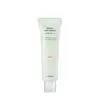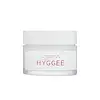What's inside
What's inside
 Key Ingredients
Key Ingredients

 Benefits
Benefits

 Concerns
Concerns

 Ingredients Side-by-side
Ingredients Side-by-side

Water
Skin ConditioningAlcohol
AntimicrobialDiethylamino Hydroxybenzoyl Hexyl Benzoate
UV FilterBis-Ethylhexyloxyphenol Methoxyphenyl Triazine
Skin ConditioningButyloctyl Salicylate
Skin ConditioningDibutyl Adipate
EmollientEthylhexyl Triazone
UV AbsorberHexyl Laurate
EmollientNiacinamide
SmoothingPolymethylsilsesquioxane
Caprylyl Methicone
Skin ConditioningSodium Acrylates Crosspolymer-2
AbsorbentChlorella Minutissima Extract
Skin ConditioningBeta Vulgaris Root Extract
Skin ConditioningIsoamyl P-Methoxycinnamate
UV AbsorberPolysilicone-15
UV Filter1,2-Hexanediol
Skin ConditioningPentylene Glycol
Skin ConditioningButylene Glycol
HumectantGlucose
HumectantSodium Polyacryloyldimethyl Taurate
Emulsion StabilisingHydroxyacetophenone
AntioxidantPolyacrylate Crosspolymer-6
Emulsion StabilisingFructooligosaccharides
HumectantFructose
HumectantEthylhexyl Olivate
Skin ConditioningSodium Acrylates Copolymer
Polyglyceryl-4 Oleate
EmulsifyingAdenosine
Skin ConditioningEthylhexylglycerin
Skin ConditioningDisodium EDTA
Water, Alcohol, Diethylamino Hydroxybenzoyl Hexyl Benzoate, Bis-Ethylhexyloxyphenol Methoxyphenyl Triazine, Butyloctyl Salicylate, Dibutyl Adipate, Ethylhexyl Triazone, Hexyl Laurate, Niacinamide, Polymethylsilsesquioxane, Caprylyl Methicone, Sodium Acrylates Crosspolymer-2, Chlorella Minutissima Extract, Beta Vulgaris Root Extract, Isoamyl P-Methoxycinnamate, Polysilicone-15, 1,2-Hexanediol, Pentylene Glycol, Butylene Glycol, Glucose, Sodium Polyacryloyldimethyl Taurate, Hydroxyacetophenone, Polyacrylate Crosspolymer-6, Fructooligosaccharides, Fructose, Ethylhexyl Olivate, Sodium Acrylates Copolymer, Polyglyceryl-4 Oleate, Adenosine, Ethylhexylglycerin, Disodium EDTA
Betula Platyphylla Japonica Juice
Skin ConditioningWater
Skin ConditioningGlycerin
HumectantDipropylene Glycol
HumectantEthylhexyl Palmitate
EmollientCetyl Ethylhexanoate
EmollientCetearyl Alcohol
EmollientNiacinamide
SmoothingMacadamia Integrifolia Seed Oil
Skin ConditioningCyclopentasiloxane
EmollientHydrogenated Vegetable Oil
Emollient1,2-Hexanediol
Skin ConditioningTheobroma Cacao Seed Butter
EmollientCitrus Aurantium Bergamia Fruit Oil
MaskingXylitol
HumectantLactobacillus Ferment
Skin ConditioningLactococcus Ferment Lysate
Skin ConditioningBifida Ferment Lysate
Skin ConditioningMacadamia Ternifolia Seed Oil
EmollientOlea Europaea Fruit Oil
MaskingSimmondsia Chinensis Seed Oil
EmollientStreptococcus Thermophilus Ferment
HumectantVitis Vinifera Seed Oil
EmollientCetearyl Glucoside
EmulsifyingDimethicone
EmollientGlyceryl Stearate
EmollientPentylene Glycol
Skin ConditioningPolyglyceryl-3 Methylglucose Distearate
EmulsifyingHydroxyethyl Acrylate/Sodium Acryloyldimethyl Taurate Copolymer
Emulsion StabilisingCetearyl Olivate
Sorbitan Olivate
EmulsifyingCaprylyl Glycol
EmollientDimethiconol
EmollientGlyceryl Caprylate
EmollientLecithin
EmollientEthylhexylglycerin
Skin ConditioningAdenosine
Skin ConditioningBisabolol
MaskingXylitylglucoside
HumectantAnhydroxylitol
HumectantHydrolyzed Hyaluronic Acid
HumectantTocopherol
AntioxidantCaprylic/Capric Triglyceride
MaskingButylene Glycol
HumectantHydrogenated Lecithin
EmulsifyingSucrose Palmitate
EmollientCeramide NP
Skin ConditioningPhospholipids
Skin ConditioningSilica Dimethyl Silylate
EmollientCholesterol
EmollientSodium Hyaluronate
HumectantHexylene Glycol
EmulsifyingArginine
MaskingPhytosterols
Skin ConditioningBehenyl Alcohol
EmollientXanthan Gum
EmulsifyingDisodium EDTA
Phenoxyethanol
PreservativeBetula Platyphylla Japonica Juice, Water, Glycerin, Dipropylene Glycol, Ethylhexyl Palmitate, Cetyl Ethylhexanoate, Cetearyl Alcohol, Niacinamide, Macadamia Integrifolia Seed Oil, Cyclopentasiloxane, Hydrogenated Vegetable Oil, 1,2-Hexanediol, Theobroma Cacao Seed Butter, Citrus Aurantium Bergamia Fruit Oil, Xylitol, Lactobacillus Ferment, Lactococcus Ferment Lysate, Bifida Ferment Lysate, Macadamia Ternifolia Seed Oil, Olea Europaea Fruit Oil, Simmondsia Chinensis Seed Oil, Streptococcus Thermophilus Ferment, Vitis Vinifera Seed Oil, Cetearyl Glucoside, Dimethicone, Glyceryl Stearate, Pentylene Glycol, Polyglyceryl-3 Methylglucose Distearate, Hydroxyethyl Acrylate/Sodium Acryloyldimethyl Taurate Copolymer, Cetearyl Olivate, Sorbitan Olivate, Caprylyl Glycol, Dimethiconol, Glyceryl Caprylate, Lecithin, Ethylhexylglycerin, Adenosine, Bisabolol, Xylitylglucoside, Anhydroxylitol, Hydrolyzed Hyaluronic Acid, Tocopherol, Caprylic/Capric Triglyceride, Butylene Glycol, Hydrogenated Lecithin, Sucrose Palmitate, Ceramide NP, Phospholipids, Silica Dimethyl Silylate, Cholesterol, Sodium Hyaluronate, Hexylene Glycol, Arginine, Phytosterols, Behenyl Alcohol, Xanthan Gum, Disodium EDTA, Phenoxyethanol
 Reviews
Reviews

Ingredients Explained
These ingredients are found in both products.
Ingredients higher up in an ingredient list are typically present in a larger amount.
1,2-Hexanediol is a synthetic liquid and another multi-functional powerhouse.
It is a:
- Humectant, drawing moisture into the skin
- Emollient, helping to soften skin
- Solvent, dispersing and stabilizing formulas
- Preservative booster, enhancing the antimicrobial activity of other preservatives
Adenosine is in every living organism. It is one of four components in nucleic acids that helps store our DNA.
Adenosine has many benefits when used. These benefits include hydrating the skin, smoothing skin, and reducing wrinkles. Once applied, adenosine increases collagen production. It also helps with improving firmness and tissue repair.
Studies have found adenosine may also help with wound healing.
In skincare products, Adenosine is usually derived from yeast.
Learn more about AdenosineButylene Glycol (or BG) is used within cosmetic products for a few different reasons:
Overall, Butylene Glycol is a safe and well-rounded ingredient that works well with other ingredients.
Though this ingredient works well with most skin types, some people with sensitive skin may experience a reaction such as allergic rashes, closed comedones, or itchiness.
Learn more about Butylene GlycolDisodium EDTA plays a role in making products more stable by aiding other preservatives.
It is a chelating agent, meaning it neutralizes metal ions that may be found in a product.
Disodium EDTA is a salt of edetic acid and is found to be safe in cosmetic ingredients.
Learn more about Disodium EDTAEthylhexylglycerin (we can't pronounce this either) is commonly used as a preservative and skin softener. It is derived from glyceryl.
You might see Ethylhexylglycerin often paired with other preservatives such as phenoxyethanol. Ethylhexylglycerin has been found to increase the effectiveness of these other preservatives.
Niacinamide is a multitasking form of vitamin B3 that strengthens the skin barrier, reduces pores and dark spots, regulates oil, and improves signs of aging.
And the best part? It's gentle and well-tolerated by most skin types, including sensitive and reactive skin.
You might have heard of "niacin flush", or the reddening of skin that causes itchiness. Niacinamide has not been found to cause this.
In very rare cases, some individuals may not be able to tolerate niacinamide at all or experience an allergic reaction to it.
If you are experiencing flaking, irritation, and dryness with this ingredient, be sure to double check all your products as this ingredient can be found in all categories of skincare.
When incorporating niacinamide into your routine, look out for concentration amounts. Typically, 5% niacinamide provides benefits such as fading dark spots. However, if you have sensitive skin, it is better to begin with a smaller concentration.
When you apply niacinamide to your skin, your body converts it into nicotinamide adenine dinucleotide (NAD). NAD is an essential coenzyme that is already found in your cells as "fuel" and powers countless biological processes.
In your skin, NAD helps repair cell damage, produce new healthy cells, support collagen production, strengthen the skin barrier, and fight environmental stressors (like UV and pollution).
Our natural NAD levels start to decline with age, leading to slower skin repair, visible aging, and a weaker skin barrier. By providing your skin niacinamide, you're recharging your skin's NAD levels. This leads to stronger, healthier, and younger looking skin.
Another name for vitamin B3 is nicotinamide. This vitamin is water-soluble and our bodies don't store it. We obtain Vitamin B3 from either food or skincare. Meat, fish, wheat, yeast, and leafy greens contain vitamin B3.
The type of niacinamide used in skincare is synthetically created.
Learn more about NiacinamidePentylene glycol is typically used within a product to thicken it. It also adds a smooth, soft, and moisturizing feel to the product. It is naturally found in plants such as sugar beets.
The hydrophilic trait of Pentylene Glycol makes it a humectant. As a humectant, Pentylene Glycol helps draw moisture from the air to your skin. This can help keep your skin hydrated.
This property also makes Pentylene Glycol a great texture enhancer. It can also help thicken or stabilize a product.
Pentylene Glycol also acts as a mild preservative and helps to keep a product microbe-free.
Some people may experience mild eye and skin irritation from Pentylene Glycol. We always recommend speaking with a professional about using this ingredient in your routine.
Pentylene Glycol has a low molecular weight and is part of the 1,2-glycol family.
Learn more about Pentylene GlycolWater. It's the most common cosmetic ingredient of all. You'll usually see it at the top of ingredient lists, meaning that it makes up the largest part of the product.
So why is it so popular? Water most often acts as a solvent - this means that it helps dissolve other ingredients into the formulation.
You'll also recognize water as that liquid we all need to stay alive. If you see this, drink a glass of water. Stay hydrated!
Learn more about Water